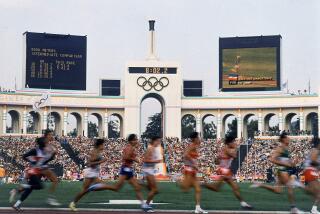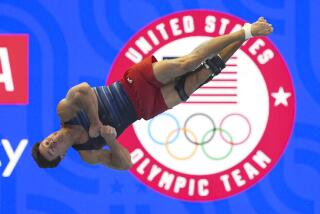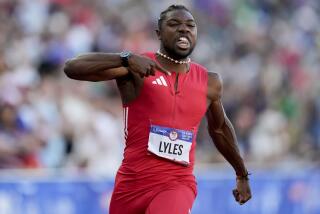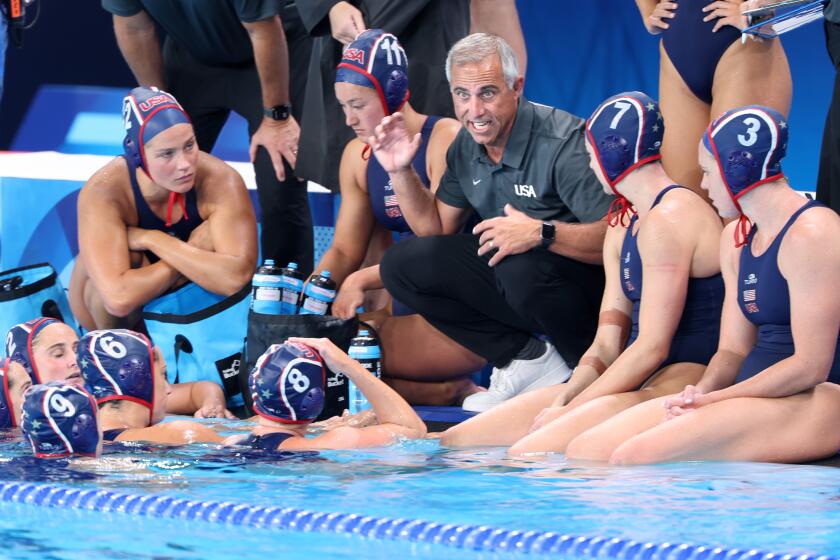Injury That Kept Maree Out of Olympics Hurt Aragon, Too
SAN DIEGO — Last July, three weeks after he edged Chuck Aragon for the third spot on the U.S. Olympic team in the 1,500 meters, Sydney Maree felt a twinge of pain in his left hamstring.
It was a small irritation, but one that foreshadowed months of pain, both in the flesh and in the spirit, for Maree and Aragon.
Two men from humble origins each saw their 1984 Olympic dream fall by the wayside.
With 35 meters to go in the 1,500-meter finals of the U.S. Track and Field Trials, four men were in a position to earn a berth on the Olympic team. Only three would make the team. Eventual winner Jim Spivey and Steve Scott were fighting for first in a furious sprint to the finish.
Maree’s peripheral vision picked up a hard-charging Aragon, who was close to overtaking him. In one of the most memorable finishes of the Trials, Aragon lunged at the tape and fell. He finished five-hundredths of a second behind Maree, and one place away from the Olympic team. He lay on the track in a heap as finishers leaped to avoid spiking him.
“I prayed three times harder,” is what Maree, the former world record-holder, said after the race to explain how he held off Aragon.
That race at the Trials was Maree’s first and last of the 1984 outdoor season. The twinge developed into an injury severe enough to keep Maree, 29, from competing in the Olympics.
The situation was enough to engender an avalanche of speculation. Was it Maree’s responsibility to declare he could not run in the Games and thus give the spot to the healthy Aragon? Or was it the job of the Olympic coaching staff to determine who was prepared to run in the Games?
Further complicating the matter were the financial ramifications of abdicating a spot on the Olympic team. On the line were endorsements and shoe company bonuses that could be worth thousands of dollars. Additionally, Maree was reportedly renegotiating his contract with the shoe company, Reebok. Maree presumably had more bargaining leverage as a member of the U.S. Olympic team.
The International Olympic Committee requires competing nations to declare their entrants well in advance of the Games. By July 18, all nations had to decide which track and field athletes would represent them in the Games.
After that deadline, according to the IOC, no substitutions would be allowed. Even in case of injury.
Maree was scheduled to run July 14 in the Jumbo Elliott Invitational but pulled out, citing a tight hamstring. Some track people thought that withdrawal should have sent up red flags among the Olympic coaches--was Sydney Maree seriously injured?
If Maree wasn’t fit to run in the Games, Aragon, as the alternate, would be placed on the team. The U.S. policy is that its athletes have to show fitness between Trials and the Games. The Olympic staff must be satisfied that those athletes who qualified for the Olympic team at the Trials have not been injured during training or competition in preparation for the Games. In some cases, athletes are called to a training site to run time trials.
Maree was not subject to the test of fitness by the Olympic staff.
“I had to go with the information we received from Sydney’s coach (Jack Pyrah),” said Larry Ellis, head coach for the U.S. Olympic men’s track and field team, in a phone interview last week. Ellis is the men’s track coach at Princeton University. “On the basis of what (the) medical input was, we made the decision. They were telling us the injury shouldn’t keep him out of the Games.
“Hindsight is a very interesting thing. We didn’t ask for a fitness test because we thought he would be back in two weeks.
Chuck Aragon was in Oslo, Norway, July 21 to run in the much-celebrated Miracle Mile. Aragon, 25, had reassembled himself emotionally after the disappointment of Trials and had decided, with his coach, to compete in Europe and make the most of the rest of the season.
His heartbreak was fresh in his mind, and in the public’s--thanks to countless televised replays of the race.
“I was walking through an airport in Chicago on my way to Europe, when this lady came up to me,” Aragon said Thursday. “She said, ‘I saw you on television and my heart went out to you. I feel for your loss.’ It was amazing to me that, in the midst of all my anger and disgust and disappointment, there were so many people supporting me.”
Maree was scheduled to run in Oslo--he was the star attraction and was reportedly paid $12,000 in appearance fees.
It was a cool night. Maree warmed up for 15 minutes and then told meet organizers he would be unable to run. It was the first time, Maree said, that he began to think he might not be able to run in the Olympics.
It was three days after the IOC deadline.
Maree once said that his life has been filled with irony. As a black South African, he was prohibited by apartheid policies from competing in his country. Yet, under the policies governing international sport, he also was prevented from competing outside South Africa.
His odyssey from impoverished beginnings led to suburban Philadelphia and Villanova University. And, in May of last year, to American citizenship. No longer, declared Maree, would he be disenfranchised in sport.
As a Latino, Aragon, from Los Lunas, a New Mexico town of 10,000, often felt disenfranchised. Through his running, he came to symbolize a way out of the dusty desert for the Latinos and Native Americans in the area.
Aragon is bright and full of dreams. He went off to college at Notre Dame--and came back to his community. He enrolled in medical school at the University of New Mexico in Albuquerque to be closer to his people. Aragon dropped out of school last year to train for the Games.
“It was only after I didn’t make the team that I realized how much I wanted it,” Aragon said quietly in an early morning interview. It was 1 a.m. and he had just finished studying for a test.
“Sometimes we pursue goals without really knowing why. I guess I was surprised that I would feel such pain--to really hurt from something. I feel I deserved a place on the Olympic team, for myself and for all those people who have supported me. But Sydney deserved it, too. He has strived, both politically and athletically, to be in the Olympic Games.
“I had heard that he was negotiating with his shoe company. As far as my comment, I guess it makes me feel uncomfortable to think about it. We try to be a little more altruistic. I don’t know. As far as his injury was concerned, Sydney did what he felt was right. He didn’t want to give up that spot. I would have done the same thing. I could have broken my leg and still run.
“I hold the places on the Olympic team to be precious. The rule is a problem. There is no reason I can see that we need to declare that much in advance. I still don’t understand it.”
For his part, Maree is attempting to exorcise the past. This indoor season has been his best ever.
“There was no question of my giving up my position,” Maree said last week. “There would have been no way I would have withdrawn with just that tightness I felt. No way. By the time I even thought of withdrawing it was too late. There was nothing to do but try to get well.
“The injury was a freakish thing. I could barely walk for seven weeks. You wake up in the middle of the night to go to the bathroom and you are constantly reminded of the injury. It was a very difficult time for me.
“I don’t understand the rule. I think it’s too much time before the Games to declare entries. But it was not my decision.”
Ellis said the United States has submitted a recommendation to the IOC to have the declaration period moved closer to the Games.
“It wasn’t improper judgment on Sydney’s part,” Ellis said. “It is really difficult for us to make that final decision so far in advance. It is just difficult.”
More to Read
Go beyond the scoreboard
Get the latest on L.A.'s teams in the daily Sports Report newsletter.
You may occasionally receive promotional content from the Los Angeles Times.








